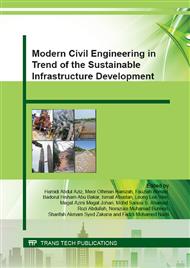p.3
p.10
p.16
p.22
p.28
p.34
p.40
p.45
Groundwater Inflows Characterization in the Pahang-Selangor Raw Water Transfer Tunnel Using δ2H and δ18O as Tracers
Abstract:
Groundwater inflows represent a very important element in hydrological circulation. Water inflows in Pahang-Selangor Raw Water Transfer Tunnel have been analyzed for isotopes stable of δ2H and δ18O. 61 samples were collected, including Tunnel Seepage Water (TSW), surface water and hot spring water samples within the study area which to understand the effect of multi topographical scale and geological characteristic. Deuterium (δ2H) and Oxygen-18 (δ18O) contributes the understanding of the origin and flow paths of water in the mountainous region. The δ2H and δ18O data obtained from TSW samples ranging from-45.73%0 to-54.68%0 and-46.01%0 to-58.49%0 are clustered along the local meteoric water line (LMWL) indicating that the groundwater originated from meteoric water. δ2H and δ18O data, primarily indicate the recharge altitude from 100m–550m which control by the sub vertical flow path mainly from geological structures (i.e. fractures and faults) followed by the groundwater. The altitude effect is indicated by the relation between the stable isotope values and elevation in meters highlighting a depletion of the heavy stable isotope with the increase of the tunnel overburden. The general trend obtained is δ2H and δ18O decreased with the increase of the overburden. The deviation of the δ2H and δ18O data from the expected trends may reflect the recharges are coming from the sub-horizontal flow path such as rivers or water infiltration from the valley. The results show that environmental isotopes indicates a better understanding of the complex hydrogeological system in a mountainous region and interaction between groundwater in granitic and meta-sedimentary rock formation along the tunnel project.
Info:
Periodical:
Pages:
22-27
Citation:
Online since:
October 2015
Keywords:
Price:
Сopyright:
© 2015 Trans Tech Publications Ltd. All Rights Reserved
Share:
Citation:


